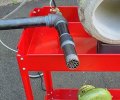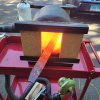- Joined
- Aug 20, 2019
- Messages
- 87
So I've built a pretty decent sized forge, imo, it's got a 18 inch long inner chamber, is a ribbon burner, pid controlled.
I'm super happy with it.
Propane consumption, I've tested this by filing my propane tank doing a session and refilling it.
So I did a 3hr forge welding session where it was at just over 2200 for most of that time. I did this twice, first time I used 2 gallons of propane, second time 1.9. So call it 2.
So I'm using 2 gallons per 3 hours. That doesn't seem bad to me and I'm ok with that. However, I have no frame reference on how that compares to other similarly sized ribbon burner forges.
Also my only annoyance, and it is a small one, is that I can get up to 2200 in about 15 minutes, the first time I put any significan amount of steel in there it will plummet in temperature like 500+ degrees. and it will take a good 10 minutes before it's back to 2200.
I believe this is because all of the refractory hasn't full absorbed the heat yet (but not 100% on that) but seems that way. Because subequently I can later on in that same session throw in some cold billets and it doesn't effect the temperature that much.
Just an oddity but also, pretty new to this all so just asking if that seems normal.
Lastly, I'm running off a 40lb tank, I notice about 2-3 hours in it'll start to freeze up. I'm going to throw it in a tub of water next time.
A bbq sized small tank takes about 30m-45m and it'll start freezing.
Should I really be sourcing a 100lb tank sooner then later to get around this?
I'm super happy with it.
Propane consumption, I've tested this by filing my propane tank doing a session and refilling it.
So I did a 3hr forge welding session where it was at just over 2200 for most of that time. I did this twice, first time I used 2 gallons of propane, second time 1.9. So call it 2.
So I'm using 2 gallons per 3 hours. That doesn't seem bad to me and I'm ok with that. However, I have no frame reference on how that compares to other similarly sized ribbon burner forges.
Also my only annoyance, and it is a small one, is that I can get up to 2200 in about 15 minutes, the first time I put any significan amount of steel in there it will plummet in temperature like 500+ degrees. and it will take a good 10 minutes before it's back to 2200.
I believe this is because all of the refractory hasn't full absorbed the heat yet (but not 100% on that) but seems that way. Because subequently I can later on in that same session throw in some cold billets and it doesn't effect the temperature that much.
Just an oddity but also, pretty new to this all so just asking if that seems normal.
Lastly, I'm running off a 40lb tank, I notice about 2-3 hours in it'll start to freeze up. I'm going to throw it in a tub of water next time.
A bbq sized small tank takes about 30m-45m and it'll start freezing.
Should I really be sourcing a 100lb tank sooner then later to get around this?



